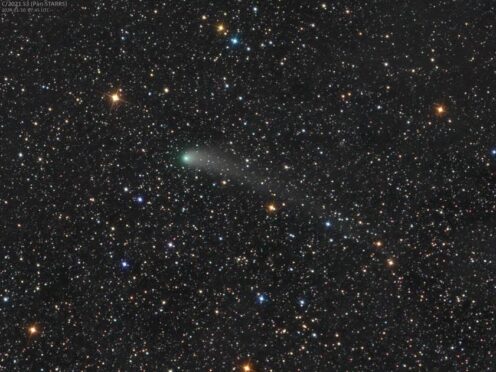Amateur stargazers have been asked to help space researchers by attempting to catch a comet with a missing tail on camera.
The comet, known as C/2021 S3 PanSTARRS, is about the same distance from Earth as the Sun and researchers from the University of Reading are keen for pictures from space enthusiasts to help with meteorological research.
The best time to capture the comet this weekend will be just before dawn each day, in dark areas away from streetlights.
Researchers are attempting to develop ways to improve and further analyse space weather.

Forecasts are crucial to prevent damage caused by solar winds, which are streams of particles containing solar storms that can damage technology both in space and on Earth.
University of Reading PhD researcher Sarah Watson, who has issued the callout to amateur stargazers, said: “What we are expecting to see may look rather unusual. When we talk about comets, people often think of a large, bright sphere followed by a long thin tail.
“The comet we are observing may look different as its tail could ‘detach’ as it is buffeted by solar winds.”
She continued: “We need lots of timed photos of the comet to build up a picture of its journey through our solar system.
“This is a fantastic opportunity for amateur astronomers to get out their telescopes, capture a truly spectacular cosmic moment and make a big contribution to some important science.”
Calling all amateur astronomers – the University of Reading needs you! ☄️
A comet will be visible in the UK night sky for the next couple of weeks and our researchers need images to help improve forecasts of space weather.
Get involved at https://t.co/nbWDhBi7Ac pic.twitter.com/GDomFGTfhz
— Uni of Reading (@UniofReading) February 20, 2024
Chris Scott, professor in space and atmospheric physics at the University of Reading, said the comet was currently visible for an hour before dawn early in the morning but the observation period would get longer over the coming months.
He said the best place to view the phenomena was somewhere dark away from streetlights, with “as dark a background as you possibly can”.
Mr Scott told the PA news agency: “We look like we’re going to be quite lucky in that there is a mass ejection that’s just erupted (from the Sun) that is travelling towards the comet, and there’s quite a high likelihood that it will interact with that comet.
“I think some time today (Saturday); our model only shows maybe a 50% chance of that happening, but there’s almost a 100% chance that it will go past it on Monday.
A highly active region of the Sun recently fired off three of the strongest type of solar flare (X-class).
The largest, an ‘X6.3’ flare released at 23:43 CET last night was the strongest solar flare observed during the current solar cycle.#SolarFlare #SpaceWeather pic.twitter.com/lAkBGOkksW
— ESA Operations (@esaoperations) February 23, 2024
“If that happens, it’s likely to really disturb the comet’s tail and it might even cause the tail to be temporarily detached, so there could be some quite spectacular images for people to get.”
Images of the comet will enable the research team to record data about solar wind conditions local to the space projectile.
If the tail detaches from the comet or appears to wobble, the team can determine there was an increase in solar wind activity nearby.
The comet has been visible in our sky since February 14 and will remain so until the end of March. The best chance to catch the comet is likely to be until Monday.
It is not visible with the naked eye.
Stargazers will need a small telescope to which they can attach a camera or a camera with a big lens to capture the comet, with the best to be sent to the British Astronomical Association to be archived.
If you just want to catch a glance of C/2021 S3 PanSTARRS, it will be easier to spot in the coming weeks as it appears further away from the sun and stays above the horizon in the night sky for longer.
